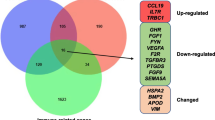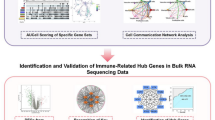Abstract
Introduction
Diabetic kidney disease (DKD) is one of the prominent microvascular complications of diabetes and the leading cause of end-stage renal disease. Inflammation plays a crucial role in the development and progression of DKD. Currently, only a few studies depict the landscape of infiltrating immune cells and their potential regulatory network in DKD. To gain a better understanding of the role of immune cells in the renal microenvironment, we sought to reveal the profile of infiltrating immune cells and their potential regulatory network in DKD.
Methods
We obtained the transcriptomes and the corresponding clinical data of 19 DKD and 25 control samples from the Gene Expression Omnibus and Nephroseq databases, respectively. Thereafter, we conducted an analysis on the infiltrating immune cells and identified immune-related differentially expressed genes through bioinformatics. Finally, correlation analyses among immune cells, immune genes, and clinical manifestations were performed, and differentially infiltrating immune cell subsets were verified through multiplex immunofluorescence staining.
Results
We demonstrated the landscape of infiltrating immune cells in patients with DKD and identified the top five hub immune regulatory genes (C3, IL7R, TYROBP, BMP2, and CXCL6). Three of the core genes (C3, BMP2, and CXCL6) were significantly correlated with the estimated glomerular filtration rate. Through multiplex immunofluorescence staining, we verified that macrophage numbers were remarkably elevated, whereas Treg cells were remarkably reduced in diabetic kidney tissues. Th2 cells were scarce in the kidney tissue.
Conclusion
Collectively, our findings shed light on new, possible therapeutic strategies for DKD, from an immune microenvironment perspective.





Similar content being viewed by others
References
Zheng Y, Ley SH, Hu FB. Global aetiology and epidemiology of type 2 diabetes mellitus and its complications. Nat Rev Endocrinol. 2018;14(2):88–98.
Cockwell P, Fisher LA. Global, regional, and national burden of chronic kidney disease, 1990–2017: a systematic analysis for the Global Burden of Disease Study 2017. Lancet. 2020;395(10225):709–33.
Cooper M, Warren AM. A promising outlook for diabetic kidney disease. Nat Rev Nephrol. 2019;15(2):68–70.
Alicic RZ, Rooney MT, Tuttle KR. Diabetic kidney disease: challenges, progress, and possibilities. Clin J Am Soc Nephrol. 2017;12(12):2032–45.
Ma L, Ni H, Zou X, Yuan Y, Luo C, Liu B, et al. Mori cortex prevents kidney damage through inhibiting expression of inflammatory factors in the glomerulus in streptozocin-induced diabetic rats. Iran J Basic Med Sci. 2017;20(6):715–21.
Chow FY, Nikolic-Paterson DJ, Ozols E, Atkins RC, Rollin BJ, Tesch GH. Monocyte chemoattractant protein-1 promotes the development of diabetic renal injury in streptozotocin-treated mice. Kidney Int. 2006;69(1):73–80.
Klessens CQF, Zandbergen M, Wolterbeek R, Bruijn JA, Rabelink TJ, Bajema IM, et al. Macrophages in diabetic nephropathy in patients with type 2 diabetes. Nephrol Dial Transplant. 2017;32(8):1322–9.
Tang PM, Nikolic-Paterson DJ, Lan HY. Macrophages: versatile players in renal inflammation and fibrosis. Nat Rev Nephrol. 2019;15(3):144–58.
Peng X, Xiao Z, Zhang J, Li Y, Dong Y, Du J. IL-17A produced by both γδ T and Th17 cells promotes renal fibrosis via RANTES-mediated leukocyte infiltration after renal obstruction. J Pathol. 2015;235(1):79–89.
Lavoz C, Matus YS, Orejudo M, Carpio JD, Droguett A, Egido J, et al. Interleukin-17A blockade reduces albuminuria and kidney injury in an accelerated model of diabetic nephropathy. Kidney Int. 2019;95(6):1418–32.
Moon JY, Jeong KH, Lee TW, Ihm CG, Lim SJ, Lee SH. Aberrant recruitment and activation of T cells in diabetic nephropathy. Am J Nephrol. 2012;35(2):164–74.
Woroniecka KI, Park AS, Mohtat D, Thomas DB, Pullman JM, Susztak K. Transcriptome analysis of human diabetic kidney disease. Diabetes. 2011;60(9):2354–69.
Miao YR, Zhang Q, Lei Q, Luo M, Xie GY, Wang H, et al. ImmuCellAI: a unique method for comprehensive T-Cell subsets abundance prediction and its application in cancer immunotherapy. Adv Sci (Weinh). 2020;7(7):1902880.
Yu G, Li F, Qin Y, Bo X, Wu Y, Wang S. GOSemSim: an R package for measuring semantic similarity among GO terms and gene products. Bioinformatics. 2010;26(7):976–8.
Stack EC, Wang C, Roman KA, Hoyt CC. Multiplexed immunohistochemistry, imaging, and quantitation: a review, with an assessment of Tyramide signal amplification, multispectral imaging and multiplex analysis. Methods. 2014;70(1):46–58.
Eardley KS, Zehnder D, Quinkler M, Lepenies J, Bates RL, Savage CO, et al. The relationship between albuminuria, MCP-1/CCL2, and interstitial macrophages in chronic kidney disease. Kidney Int. 2006;69(7):1189–97.
Lv LL, Tang PM, Li CJ, You YK, Li J, Huang XR, et al. The pattern recognition receptor, Mincle, is essential for maintaining the M1 macrophage phenotype in acute renal inflammation. Kidney Int. 2017;91(3):587–602.
Toki D, Zhang W, Hor KL, Liuwantara D, Alexander SI, Yi Z, et al. The role of macrophages in the development of human renal allograft fibrosis in the first year after transplantation. Am J Transplant. 2014;14(9):2126–36.
Kim SM, Lee SH, Lee A, Kim DJ, Kim YG, Kim SY, et al. Targeting T helper 17 by mycophenolate mofetil attenuates diabetic nephropathy progression. Transl Res. 2015;166(4):375–83.
Dong L, He Y, Cao Y, Wang Y, Jia A, Wang Y, et al. Functional differentiation and regulation of follicular T helper cells in inflammation and autoimmunity. Immunology. 2020;163(1):19–32.
Dang EV, Barbi J, Yang HY, Jinasena D, Yu H, Zheng Y, et al. Control of T(H)17/T(reg) balance by hypoxia-inducible factor 1. Cell. 2011;146(5):772–84.
Eller K, Kirsch A, Wolf AM, Sopper S, Tagwerker A, Stanzl U, et al. Potential role of regulatory T cells in reversing obesity-linked insulin resistance and diabetic nephropathy. Diabetes. 2011;60(11):2954–62.
Tang S, Wang X, Deng T, Ge H, Xiao X. Identification of C3 as a therapeutic target for diabetic nephropathy by bioinformatics analysis. Sci Rep. 2020;10(1):13468.
Morigi M, Perico L, Corna D, Locatelli M, Cassis P, Carminati CE, et al. C3a receptor blockade protects podocytes from injury in diabetic nephropathy. JCI Insight. 2020. https://doi.org/10.1172/jci.insight.131849.
Cui J, Wu X, Song Y, Chen Y, Wan J. Complement C3 exacerbates renal interstitial fibrosis by facilitating the M1 macrophage phenotype in a mouse model of unilateral ureteral obstruction. Am J Physiol Renal Physiol. 2019;317(5):F1171-f82.
Liu Y, Wang K, Liang X, Li Y, Zhang Y, Zhang C, et al. Complement C3 produced by macrophages promotes renal fibrosis via IL-17A secretion. Front Immunol. 2018;9:2385.
Zheng QY, Liang SJ, Li GQ, Lv YB, Li Y, Tang M, et al. Complement component 3 deficiency prolongs MHC-II disparate skin allograft survival by increasing the CD4(+) CD25(+) regulatory T cells population. Sci Rep. 2016;6:33489.
Gao X, Liu H, Ding G, Wang Z, Fu H, Ni Z, et al. Complement C3 deficiency prevent against the onset of streptozotocin-induced autoimmune diabetes involving expansion of regulatory T cells. Clin Immunol. 2011;140(3):236–43.
Li Z, Liu J, Wang W, Zhao Y, Yang D, Geng X. Investigation of hub genes involved in diabetic nephropathy using biological informatics methods. Ann Transl Med. 2020;8(17):1087.
Yang YL, Liu YS, Chuang LY, Guh JY, Lee TC, Liao TN, et al. Bone morphogenetic protein-2 antagonizes renal interstitial fibrosis by promoting catabolism of type I transforming growth factor-beta receptors. Endocrinology. 2009;150(2):727–40.
Cohen A, Polak D, Nir-Paz R, Westreich N, Casap N. Indirect bactericidal properties of recombinant human bone morphogenetic protein 2 in vitro. J Oral Maxillofac Surg. 2019;77(8):1611–6.
Wei F, Zhou Y, Wang J, Liu C, Xiao Y. The immunomodulatory role of BMP-2 on macrophages to accelerate osteogenesis. Tissue Eng Part A. 2018;24(7–8):584–94.
Sun MY, Wang SJ, Li XQ, Shen YL, Lu JR, Tian XH, et al. CXCL6 promotes renal interstitial fibrosis in diabetic nephropathy by activating JAK/STAT3 signaling pathway. Front Pharmacol. 2019;10:224.
Besnard AG, Struyf S, Guabiraba R, Fauconnier L, Rouxel N, Proost P, et al. CXCL6 antibody neutralization prevents lung inflammation and fibrosis in mice in the bleomycin model. J Leukoc Biol. 2013;94(6):1317–23.
Shen YL, Jiang YP, Li XQ, Wang SJ, Ma MH, Zhang CY, et al. ErHuang formula improves renal fibrosis in diabetic nephropathy rats by inhibiting CXCL6/JAK/STAT3 signaling pathway. Front Pharmacol. 2019;10:1596.
Acknowledgements
The authors would like to thank the Woroniecka et al for providing transcriptional data and Panovue Biotechnology inc. (Beijing, China) for providing technical guidance of multiplex immunofluorescence staining.
Funding
This study was supported by the Natural Science Foundation of Jiangxi Province (no. 20224BAB216009), Youth Talent Training Program of First Affiliated Hospital of Nanchang University (no.YFYPY202113), and the Science and Technology Plan of Jiangxi Health Planning Committee (no. 202210484).
Author information
Authors and Affiliations
Contributions
JW,WC and YH collected and analyzed the data; JW, SC,and GY analyzed and interpreted the data; JX conceived the study. All authors reviewed and edited the manuscript.
Corresponding author
Ethics declarations
Conflict of interest
There are no conflicts of interest to report.
Ethical approval
Study protocols for obtaining the paraffin-embedded specimens were approved by the First Affiliated Hospital of Nanchang University’s committee, and the samples were obtained after written informed consent.
Additional information
Publisher's Note
Springer Nature remains neutral with regard to jurisdictional claims in published maps and institutional affiliations.
About this article
Cite this article
Wang, J., Chen, W., Chen, S. et al. Landscape of infiltrating immune cells and related genes in diabetic kidney disease. Clin Exp Nephrol 28, 181–191 (2024). https://doi.org/10.1007/s10157-023-02422-1
Received:
Accepted:
Published:
Issue Date:
DOI: https://doi.org/10.1007/s10157-023-02422-1




